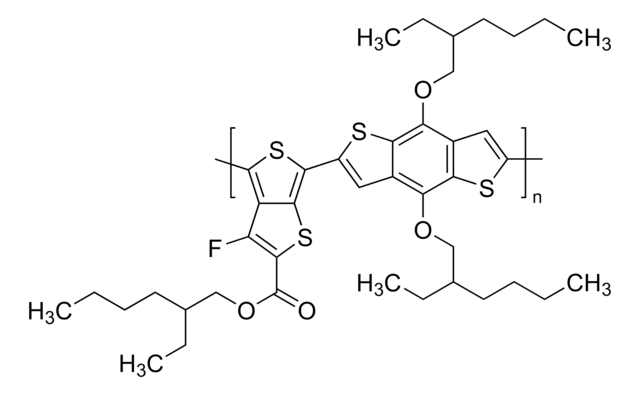If this product has an expiration or retest date, it will be shown on the Certificate of Analysis (COA, CofA). If there is no retest or expiration date listed on the product's COA, we do not have suitable stability data to determine a shelf life. For these products, the only date on the COA will be the release date; a retest, expiration, or use-by-date will not be displayed.
For all products, we recommend handling per defined conditions as printed in our product literature and website product descriptions. We recommend that products should be routinely inspected by customers to ensure they perform as expected.
For products without retest or expiration dates, our standard warranty of 1 year from the date of shipment is applicable.
For more information, please refer to the Product Dating Information document: https://www.sigmaaldrich.com/deepweb/assets/sigmaaldrich/marketing/global/documents/449/386/product-dating-information-mk.pdf
702471
PTAA
a poly(triaryl amine) semiconductor
Synonyme(s) :
Poly(triaryl amine), Poly[bis(4-phenyl)(2,4,6-trimethylphenyl)amine]
About This Item
Produits recommandés
Forme
solid
Poids mol.
average Mn 7,000-10,000 (GPC)
Caractéristiques du produit alternatif plus écologique
Design for Energy Efficiency
Learn more about the Principles of Green Chemistry.
sustainability
Greener Alternative Product
Pf
>400 °C
>400 °C
Mw/Mn
2‑2.2
Application(s)
battery manufacturing
semiconductor
Autre catégorie plus écologique
, Enabling
Propriétés du semi-conducteur
P-type (mobility=10−3 - 10−2 cm2/V·s)
Description générale
Code de la classe de stockage
11 - Combustible Solids
Classe de danger pour l'eau (WGK)
WGK 3
Point d'éclair (°F)
Not applicable
Point d'éclair (°C)
Not applicable
Équipement de protection individuelle
Eyeshields, Gloves, type N95 (US)
Faites votre choix parmi les versions les plus récentes :
Déjà en possession de ce produit ?
Retrouvez la documentation relative aux produits que vous avez récemment achetés dans la Bibliothèque de documents.
Les clients ont également consulté
-
How can I determine the shelf life / expiration / retest date of this product?
1 answer-
Helpful?
-
-
How is shipping temperature determined? And how is it related to the product storage temperature?
1 answer-
Products may be shipped at a different temperature than the recommended long-term storage temperature. If the product quality is sensitive to short-term exposure to conditions other than the recommended long-term storage, it will be shipped on wet or dry-ice. If the product quality is NOT affected by short-term exposure to conditions other than the recommended long-term storage, it will be shipped at ambient temperature. As shipping routes are configured for minimum transit times, shipping at ambient temperature helps control shipping costs for our customers. For more information, please refer to the Storage and Transport Conditions document: https://www.sigmaaldrich.com/deepweb/assets/sigmaaldrich/marketing/global/documents/316/622/storage-transport-conditions-mk.pdf
Helpful?
-
-
What is the molecular weight of PTAA with product no. 702471? and how much-optimized quality of this product is needed in one milliliter of solvent (Toluene) to coat it as a Hole transporting layer for perovskite solar cells. share some PSCs articles.
1 answer-
The number molecular weight is reported in the lot-specific Certificate of Analysis. Please access the link below to review a sample or lot specific Certificate:
https://www.sigmaaldrich.com/product/aldrich/702471#product-documentationThe average molecular weight of this material is not reported. However, historical data indicates a range of 17,000 - 20,000 g/mol.
Unfortunately, the concentration of PTAA in toluene for Hole transporting layer coating is not tested. Here is a review paper as a reference:
PTAA as Efficient Hole Transport Materials in Perovskite Solar Cells: A Review
Sol. RRL 2022, 6, 2200234.Helpful?
-
Active Filters
Notre équipe de scientifiques dispose d'une expérience dans tous les secteurs de la recherche, notamment en sciences de la vie, science des matériaux, synthèse chimique, chromatographie, analyse et dans de nombreux autres domaines..
Contacter notre Service technique
![Poly[bis(4-phenyl)(2,4,6-trimethylphenyl)amine]](/deepweb/assets/sigmaaldrich/product/structures/288/293/16f2da62-4f58-4b77-926a-5bf2a96e0ad8/640/16f2da62-4f58-4b77-926a-5bf2a96e0ad8.png)
![[6,6]-Phenyl C61 butyric acid methyl ester ≥99%](/deepweb/assets/sigmaaldrich/product/structures/359/221/d990c746-0960-4c69-bf76-fe09b193824d/640/d990c746-0960-4c69-bf76-fe09b193824d.png)









